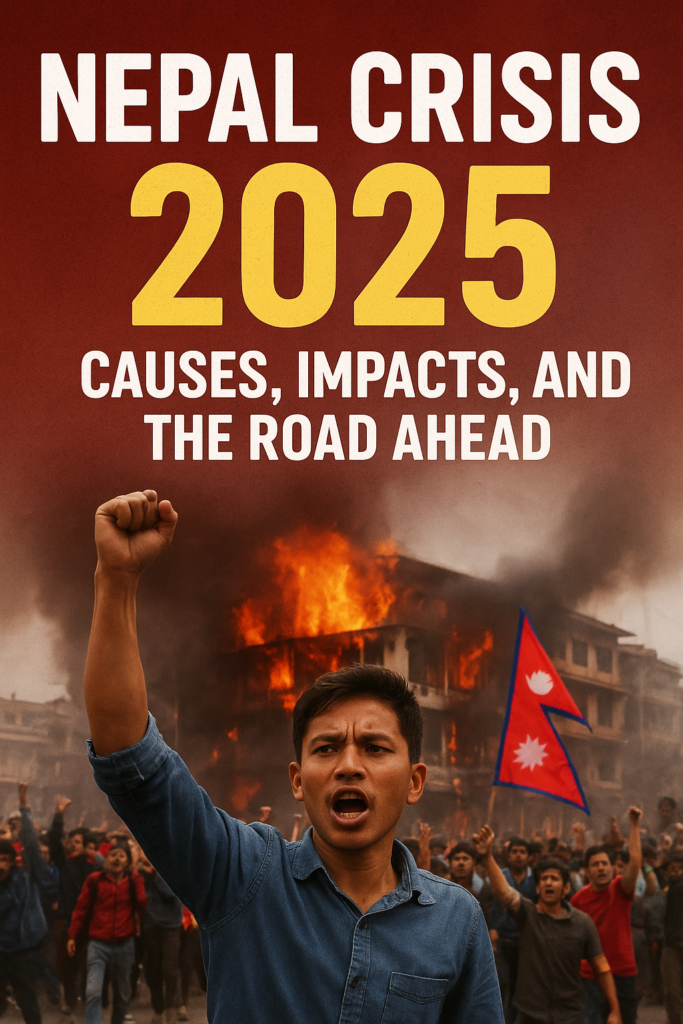Nepal, the beautiful Himalayan country known for Mount Everest, friendly people, and rich culture, is unfortunately in the middle of a serious political and economic crisis in 2025. What started as anger against a social media ban has now grown into nationwide protests, political instability, and deep economic worries. In this blog you will get full information about Nepal Crisis 2025.
In this blog, we will explain the Nepal crisis in easy language, covering its causes, key events, economic and social impacts, and possible solutions.
What Started the Crisis in Nepal?
1: Ban on Social Media
In September 2025, the Nepal government banned popular social media platforms like Facebook, Instagram, WhatsApp, X (Twitter), and YouTube.
The government said these platforms must register under new rules, but the public felt it was censorship and an attack on freedom of speech.
For Nepal’s young generation, who use social media to connect, share ideas, and express their opinions, this was the last straw.
2: Corruption and Nepotism
For years, people have been unhappy with corruption in politics, lack of accountability, and nepotism (giving jobs or favors to friends and relatives).
Citizens feel that leaders focus more on power and benefits for themselves instead of solving real problems like jobs, inflation, and education.
3: Youth Unemployment and Economic Stress
Nepal has a very high youth unemployment rate (around 20–22%).
Many young people go abroad to work because there are not enough jobs in Nepal.
The economy depends too much on remittances (money sent home by Nepalis working abroad).
Rising prices of food, fuel, and medicine made the frustration worse.
4: Political Instability
Nepal has seen many governments in the last two decades. No single government has been able to complete its full term.
Frequent changes in leadership mean no long-term policies and no consistency in development work.
Key Events of the Nepal Crisis 2025

Protests by Youth (Gen Z Movement):
After the social media ban, thousands of young people came to the streets in Kathmandu and other cities. They demanded freedom, jobs, and honest governance.
Violence and Clashes:
The protests turned violent when security forces used tear gas, water cannons, and rubber bullets. Protesters also set fire to government buildings like Parliament, the Supreme Court, and the Prime Minister’s office.
Deaths and Injuries:
Sadly, around 20 people were killed and hundreds were injured during the clashes.
Resignation of Prime Minister KP Sharma Oli:
Under massive pressure from protests and loss of control, PM Oli resigned from his position.
Nepal’s First Female Prime Minister:
The Supreme Court appointed Sushila Karki as interim Prime Minister, making her the first woman in Nepal’s history to hold this post. She will lead until new elections in March 2026.
Economic Impact of the Crisis
Slower Economic Growth
- Nepal’s economy was already weak, with growth around 4.5% in 2024–25.
- Political instability and protests have scared away investors and tourists.
- Many businesses are facing losses.
Inflation and Price Hike
- The cost of daily goods like rice, vegetables, petrol, and medicine has increased sharply.
- Border disruptions with India made supplies difficult, leading to shortages.
Banking and Financial Problems
- Many banks and cooperatives are struggling with bad loans.
- People are losing trust in financial institutions.
Dependence on Remittances
- Nepal earns a big part of its income from Nepalis working in Gulf countries, Malaysia, and India.
- This money supports families but does not create jobs inside Nepal.
- If global economies slow down, Nepal will face even more problems.
Social Impact of the Nepal Crisis
Frustrated Youth
- Young people feel ignored by leaders.
- Many are thinking of leaving the country for better opportunities, causing a possible brain drain.
Loss of Trust in Government
- People no longer believe that politicians care about citizens’ problems.
- Trust in institutions like courts, police, and media is also weakening.
Impact on Daily Life
- Schools, colleges, and offices have been affected by strikes and protests.
- Families dependent on daily wages are struggling the most.
Also Read : Donald Trump: From Real Estate Mogul to President – Complete Information
International Dimension
Nepal is a small country between India and China, two powerful neighbors.
Political instability in Nepal also worries these countries, as both want influence in the region.
Nepal has also been put under the FATF grey list, which shows concerns about financial transparency and money laundering. This makes it harder to attract foreign investment.
What Can Be the Solution?
Transparent Governance
- Strict action against corruption and misuse of power.
- More accountability from leaders.
Youth Employment Programs
- Investment in industries like IT, hydropower, tourism, and agriculture.
- Vocational training and startup support for young people.
Freedom of Expression
- Government must allow people to use social media and speak freely.
- Dialogue instead of bans and force.
Economic Reforms
- Strengthen banks and cooperatives.
- Reduce dependence on remittances by developing local industries.
Stable Politics
- Leaders should work together for long-term national interest, not just for power.
- March 2026 elections should be free, fair, and transparent.
Conclusion
The Nepal crisis of 2025 is not just about the ban on social media. It reflects years of frustration due to corruption, unemployment, rising prices, and political instability. The protests show that the youth want change, honesty, and opportunities.
The appointment of Sushila Karki as interim Prime Minister is a historic step, but it is only the beginning. Real progress will come only when leaders bring reforms, jobs, transparency, and respect for freedom.
Nepal is at a turning point. If handled wisely, this crisis can become a chance for a new beginning. But if ignored, it could lead to more instability and suffering for its people.
Keywords :
Nepal crisis 2025, Nepal protests news, Social media ban in Nepal, Youth unemployment in Nepal, Nepal political instability, Nepal interim government, Sushila Karki Prime Minister, Nepal corruption and governance, Nepal economic slowdown, Future of Nepal politics
